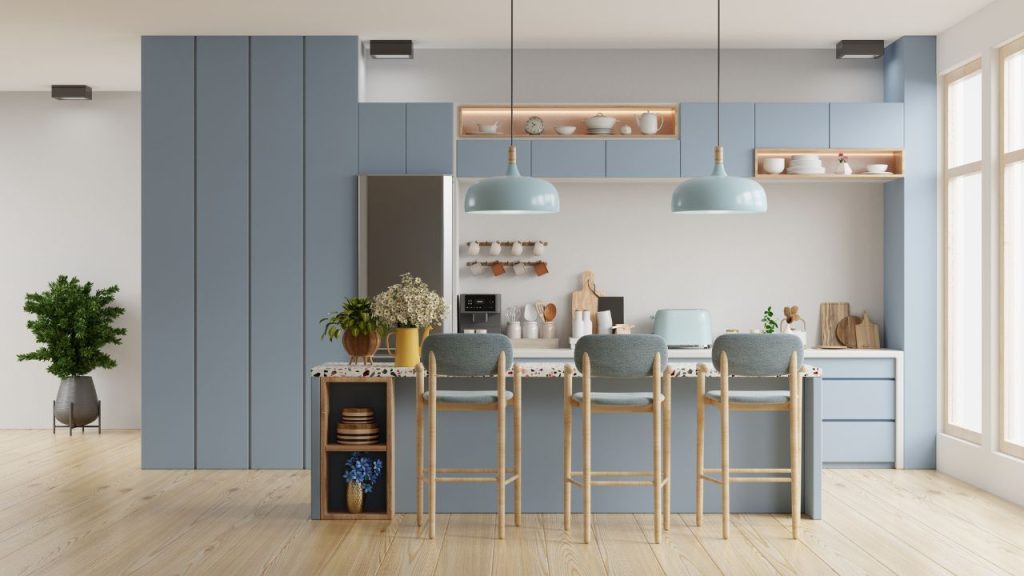Is your kitchen drowning in clutter? From kitchen organisation to tidying systems: Our advice will help you maintain lasting order.
The kitchen is the heart of every home, and not just because we prepare breakfast, lunch, and dinner here. It’s also the most social and emotional space in the house. It’s where we meet, converse, debate – occasionally there might be a falling out – and then reconcile. As we know, the best parties always take place in the kitchen, regardless of whether it’s a separate room or an open-plan living kitchen.
For these reasons, good kitchen planning is crucial. Cooking and celebrating are even better in a clean and well-organised kitchen.
Where to begin? The first step to organising the kitchen. Countertops are cluttered, drawers and cabinets are in utter disarray, and just the sight of it feels overwhelming. Where and how do you even begin? Don’t panic! Before tidying up, you must first declutter.
Remove everything from the cabinets and drawers, preparing bin bags and baskets. Dispose of any expired food, and only keep the kitchen tools you truly use. This is especially vital for minimalist kitchens with limited space. Any appliances you haven’t used in the past year or have duplicates of can be given away or sold.
When decluttering, try to organise items into categories. For example, separate food supplies from kitchen tools, cutlery from dishes, and containers from pots and pans.
A book and series tip: A certain Japanese method, famous worldwide, advocates this approach. Keeping only what you truly need and what brings you joy ensures order and, according to the method, not only frees your home from unnecessary clutter but also the soul.
The goal of perfect kitchen organisation: Use available space and put everything away. Store as much as possible inside cabinets and drawers. Even cloths and washing up liquid should be tucked away. Depending on the kitchen size, this can be easier said than done, especially if storage space is limited. But even so, there are clever solutions – more on that later.
The major advantage of a clear countertop? Not only do you have ample space for future cooking endeavours, but cleaning also becomes a breeze.
5 Kitchen Zones: Ensuring Efficient Kitchen Organisation. While decluttering, you’ve already sorted items into categories. Now, maintain this system. Professionals divide the kitchen into five zones for maximum efficiency:
- Cooking and Baking Zone Keep cooking tools like pans and spatulas within easy reach of the hob. Baking tins and trays should be near the oven.
The area around the sink and dishwasher should have convenient storage for cleaning supplies and bin bags.
The countertop serves as the prep area. Surrounding drawers can house frequently used preparation tools, such as open food items, spices, oils, utensils, and chopping boards.
Plates, cups, glasses, bowls, and containers should be stored outside the cooking and prep zones, preferably close to the washing area. This ensures quick access when unloading the dishwasher. Infrequently used gadgets can also be stored here.
Tall cabinets are an alternative to larders, ideal for storing dried pasta, rice, tea, coffee, cereals, and tins.
Practical Organisation for the Kitchen: Tidying Systems for Drawers and Cabinets. Storing all tools and appliances in designated spots is essential, but maintaining organisation within these storage areas is equally crucial.
- Organising Drawers In shallow drawers, store small kitchen tools and accessories like cutlery. To keep things orderly, consider a drawer organiser. There are various sizes and materials available, and some even stack cutlery diagonally for optimal space use.
Deep drawers are suitable for pots and casserole dishes. Drawer dividers are handy for organising tools and are versatile for any section, helping separate things like rubbish bags, cleaning supplies, containers, and gadgets.
Tip: Using a side compartment, you can store frying pans vertically. Stands are also available that work well for pots and pans.
For shallow drawers near the hob, consider a tiered spice holder to ensure labels are always visible and the containers are neatly stored.
Kitchen knives can be stored in shallow drawers with a fitted tray. If space is tight, a knife block on the countertop or a magnetic strip mounted at child-safe height can work.
- Sorting Kitchen Cabinets Organise cabinets by category. Place plates on the first shelf, glasses on the second, and so on.
For those using a cabinet for oils, vinegars, or spices, consider installing lazy susans for easier access. Alternatively, spice racks can be attached to the inside of cabinet doors.
- Organising the Pantry When filling your pantry, maintain order. This means categorising your supplies and storing each group separately, either on individual shelves or in bins. For example, group pasta, baking ingredients, cereals, and spreads. Clear containers or labelled bins ensure you see everything at a glance, streamlining both cooking and restocking.
Tip: When opening a new packet of cereal or flour, consider transferring the remainder to a storage jar and labelling it. This not only aids organisation but is also sustainable and prevents pests.
- Organising the Corner Cabinet Ideally, corner cabinets should feature a carousel for easy access, perfect for pots and appliances. If not, store infrequently used items, such as a waffle iron or juicer.
- Organising an Open Shelf in the Kitchen Not every kitchen has ample storage, and often there are open shelves. To prevent them from becoming cluttered, rely on containers and storage jars. Uniform designs can look aesthetically pleasing. Use this zone for decoration, showcasing herbs or your finest china. But remember: Less is more. Shelves shouldn’t be overcrowded. sink tidy
Fancy a kitchen makeover? Here, you’ll find many helpful tips and beautiful ideas for kitchen decoration.
Tip: Adding hooks to walls or the undersides of shelves allows for hanging ladles or mugs.
Whether you’re planning a larger kitchen, designing an open-plan kitchen, setting up a small kitchen, or merely wanting to tidy up your current one, following these helpful tips ensures your organised kitchen won’t descend into chaos anytime soon.



